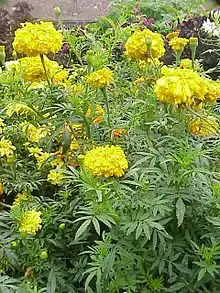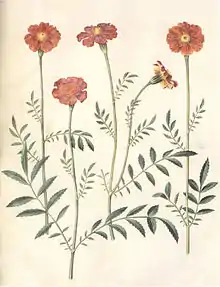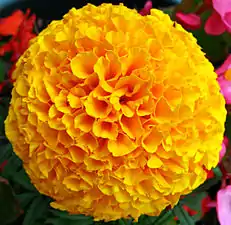Tagetes erecta
Tagetes erecta, the Mexican marigold or Aztec marigold,[2] is a species of the genus Tagetes native to Mexico. Despite its being native to the Americas, it is often called African marigold.[3][4] In Mexico, this plant is found in the wild in the states of México, Michoacán, Puebla, and Veracruz.
| Tagetes erecta | |
|---|---|
 | |
| Scientific classification | |
| Kingdom: | Plantae |
| Clade: | Tracheophytes |
| Clade: | Angiosperms |
| Clade: | Eudicots |
| Clade: | Asterids |
| Order: | Asterales |
| Family: | Asteraceae |
| Genus: | Tagetes |
| Species: | T. erecta |
| Binomial name | |
| Tagetes erecta | |
| Synonyms[1] | |
|
List
| |
This plant reaches heights of between 20 and 90 cm (7.9 and 35.4 in). The Aztecs gathered the wild plant as well as cultivating it for medicinal, ceremonial and decorative purposes. It is widely cultivated commercially with many cultivars in use as ornamental plants,[5] and for the cut-flower trade.[6][7]
Some authorities regard Tagetes patula (the French marigold) as a synonym of Tagetes erecta.[8]
Description
It is a herbaceous annual or perennial whose height ranges from 30–110 cm. The root is cylindrical, pivoting, with a fibrous and shallow branching system. The stem is striated, sometimes ridged, smooth or slightly with villi, cylindrical, oval and herbaceous to slightly woody, with resin channels in the bark, which are aromatic when squeezed. Opposite leaves at the bottom alternate at the top, up to 20 cm long, pinnate, composed of 11 to 17 leaflets, lanceolate to linear-lanceolate, up to 5 cm long and 1.5 cm wide, acute to acuminate, serrated to sub-holders, the lower ones of each leaf frequently setiform (in the form of threads), the superiors are sometimes completely setiform; with abundant round glands.[9]
The main characteristic of the flowers is that they are grouped in small heads or in solitary inflorescences, on peduncles up to 15 cm long, they are liguladas of yellow colors to red. In the flowers of the disc: 150 to 250 in the simple heads, in the doubles it shows different degrees of transformation in ligules, yellow to orange corollas, of 8 to 10 mm in length. The fruits and seeds are: linear achenes 7 to 10 mm long, smooth or slightly covered with stiff hairs at the corners. 1 2 3 has a long flowering period extending throughout the summer and fall. It reproduces easily by seeds.[10]
Distribution
Although native to Mexico, they are also found in the countries of Central America and the Caribbean: Belize, Bolivia, Colombia, Costa Rica, Cuba, Ecuador, El Salvador, Guatemala, Guyana, Honduras, Jamaica, Nicaragua, Panama, Puerto Rico, and Venezuela.[11]
In their wild form they are found in the Balsas basin and western Mexico and live in diverse types of ecosystems, such as tropical deciduous forests, thorny forests, cloud forests and pine-oak forests. In the wild, it is found as a getaway in heavily disturbed places at altitudes of 800–2300 m.[12]
As an introduced species (cultivated) it can be found in China, India, Zambia, South Africa and Australia.
History

The archaeological record of the use of Tagetes erecta among pre-Hispanic civilizations is not as abundant as in the case of other species of the same family. It has been proposed the identification of Tagetes erecta of some flowers represented in Aztec art, such as those seen in the monolith of Coyolxauhqui, as part of the headdress of the goddess, proposed as a symbol of their sovereignty or death; also form part of the collar wears a god plant in a vase found in the Templo but also could be Tagetes patula. With the arrival of the Spaniards in Mexico, the documentary record of the ceremonial and medicinal use of the Tagetes erecta increased in which the flower is described by Bernardino de Sahagún as:[13]
These flowers are called Cempoalxóchitl; they are yellow and of good smell, and wide and beautiful, that they are born, and others that sow them in the orchards; They are in two ways, some they call females Cempoalxóchitl and they are big and beautiful, and others that are called Cempoalxóchitl males are not so beautiful or so big.
Sahagún also describes, in the same work, that the plant had a role in the rituals of the religious festival Mexica of the month Teculhuitontli, where the goddess of salt Huixtocíhuatl, whose color was yellow, was celebrated and who offered herself as sacrifice a woman. In the work of the physician Francisco Hernández, it is described that the name cempoalxóchitl received at least seven types of flowers, noting that the term properly described the largest of them and that the Spaniards called it carnation of Indian, also lists its medical properties.[14]
Cultivation
It is widely cultivated and there are many cultivars used in gardening as an ornamental plant. The cultivar ‘Inca Orange’ has gained the Royal Horticultural Society’s Award of Garden Merit.[15][16]
In Mexico, it is used in the festivities of the Day of the Dead, to decorate altars and tombs; hence the name "flower of the dead". However, since antiquity it is also used for food and medicinal purposes.
Uses
Rituals
Its flower, the cempasúchil is also called the flor de muertos ("flower of the dead") in Mexico and is used in the Día de Muertos celebration every 2 November. The word cempazúchitl (also spelled cempasúchil) comes from the Nahuatl term for the flower cempohualxochitl, literally translated as "twenty flower".[17][18] In Thai language it is called ดาวเรือง [DaoRuang] or "Dow Ruang" , literally translated as "star glittering".[19] Water infused with the fragrant essential oil of the flower was used to wash corpses in Honduras, and the flower is still commonly planted in cemeteries.[20]
Medicine
Since prehispanic times, this plant has been used for medicinal purposes. The Cherokee used it as a skin wash and for yellow dye.[21] The pigments of the erect tagetes are due to the presence of carotenoids, of which the main one is lutein, which is associated with the prevention of the development of age-related eye diseases such as cataracts and macular degeneration. The most intense orange tones of the flowers are related to a higher content of carotenoids, especially xanthophyll. Some studies indicate the effectiveness of the latter in the prevention of coronary artery disease, heart attacks, immune response, old age and cancer. In some regions of Mexico it is used in digestive ailments, such as stomach pain, as well as diarrhea, colic, liver problems, bile, vomiting, and indigestion. The plant also has a history of use against intestinal parasites and worms with one study indicating that it has a different mechanism than the anthelmintic drug levamisole.[22] Other uses include respiratory diseases such as colds, flu, bronchitis and nasal congestion as well as gynecological problems.[23]
Antioxidant activity has been discovered in the essential oil of this plant although less than that of α-Tocopherol, possibly attributable to the presence of camphor and methyl eugenol[24] It is most effective against the nematode species Pratylenchus penetrans.[20]
Culinary
The ray florets have been used in lettuce salads and other foods to add colour and flavour. The flowers are rich in carotenoids, and are thus used to make food and feed pigments.[25] The dried flower petals, ground to a powder, are used in poultry feed to ensure a good colouration of egg yolks and broiler skin, especially in the absence of well-pigmented yellow maize in the feed.[26] This is still in use today, but now usually in the form of an extract which may have advantages of lower transport and storage cost, better stability and better utilization. It is also used to enhance colouring in crustaceans,[20] such as the Pacific white shrimp (Litopenaeus vannamei).[27]
Essential oils
The essential oil of the flower contains antioxidants.[28] It may be added to perfumes to infuse an apple scent into them.
Dye
It is also used as a natural dye on textiles.[29]
Gallery

.JPG.webp) Bud of Tagetes erecta in India
Bud of Tagetes erecta in India Flower
Flower French Marigold flower
French Marigold flower Flowerbed
Flowerbed Sprouting flowers
Sprouting flowers Flower
Flower
References
- The Plant List, Tagetes erecta L.
- "Tagetes erecta". Natural Resources Conservation Service PLANTS Database. USDA. Retrieved 7 December 2015.
- Floridata
- "Tagetes erecta". Germplasm Resources Information Network (GRIN). Agricultural Research Service (ARS), United States Department of Agriculture (USDA). Retrieved 16 December 2017.
- NC State Horticulture
- Flora of China, Tagetes erecta Linnaeus, 1753. 万寿菊 wan shou ju
- Altervista Flora Italiana, Tagete eretta, Tagetes erecta L.
- "Tagetes patula". The Plant List. Retrieved 1 December 2018.
- Rzedowski J and Rzedowski GC. 2005. Fanerogamic Flora of the Valley of Mexico. Vol. II 1st edition. National School of Biological Sciences, IPN and Institute of Biology. Mexico City.
- Vázquez-García L. M., Víveros-Farfán I. M. G. and Salomé-Castañeda E. 2002. Cempasúchil (Tagetes spp.) Ornamental Phytogenetic Resources of Mexico. University of the State of Mexico. 28-67.
- Villaseñor R., J. L. and F. J. Espinosa G., 1998. Catalog of weeds of Mexico. National Autonomous University of Mexico. National Consultative Phytosanitary Council. Fund of Economic Culture. Mexico City.
- Heyden, Doris (1987). «Symbolism of ceramics from the Templo Mayor». The Aztec Templo Mayor: A Symposium at Dumbarton Oaks, 8th and 9th October 1983 (Dumbarton Oaks). ISBN 9780884021490
- Eckehart J. Jäger, Friedrich Ebel, Peter Hanelt, Gerd K. Müller (ed.): Excursion flora of Germany . Founded by Werner Rothmaler. Volume 5 : Herbaceous ornamental and useful plants . Springer, Spektrum Academic Publisher, Berlin / Heidelberg 2008, ISBN 978-3-8274-0918-8, p 603 .
- Serrato-Cruz M. A. 2005. Collection, characterization and use of Tagetes erecta L. As ornamental; Advances X National Congress and III International Ornamental Horticulture. Michoacán University of San Nicolás de Hidalgo. Michoacán, Mexico
- "RHS Plantfinder - Tagetes 'Inca Orange'". Retrieved 1 December 2018.
- "AGM Plants - Ornamental" (PDF). Royal Horticultural Society. July 2017. p. 100. Retrieved 1 December 2018.
- "Day of the Dead Flowers". Copal, Mexican Folk Art at its best Online. Retrieved 3 April 2020.
- "Marigold: the typical flower to celebrate the Day of The Dead". www.floraldaily.com. Retrieved 3 April 2020.
- Xu, Li-Wei; Wang, Guo-Ying; Yan-Ping, Shi (May 2011). "Chemical constituents from Tagetes erecta flowers". Chemistry of Natural Compounds. 47 (2): 81–283. doi:10.1007/s10600-011-9905-5. S2CID 38292218.
- Protabase: Tagetes erecta Archived 2017-10-18 at the Wayback Machine
- Ethnobotany
- Piña-Vázquez, DM; Mayoral-Peña, Z; Gómez-Sánchez, M; Salazar-Olivo, LA; Arellano-Carbajal, F (18 April 2017). "Anthelmintic effect of Psidium guajava and Tagetes erecta on wild-type and Levamisole-resistant Caenorhabditis elegans strains". Journal of Ethnopharmacology. 202: 92–96. doi:10.1016/j.jep.2017.03.004. PMID 28286043.
- E. Prinz: "Dyeing plants - Instructions for dyeing, use in culture and medicine" Verlag Schweizerbart, Stuttgart 2009, ISBN 978-3-510-65258-7, p 53.
- Olabiyi, T. I. & E. E. A. Oyedunmade (2007). "Marigold (Tagetes erecta L.) as interplant with cowpea for the control of nematode pests" (PDF). African Crop Science Conference Proceedings. 8: 1075–1078.
- Heuzé V., Tran G., Hassoun P., Lebas F., 2017. Mexican marigold (Tagetes erecta). Feedipedia, a programme by INRA, CIRAD, AFZ and FAO. https://www.feedipedia.org/node/90 Last updated on August 24, 2017, 15:11
- W. Leigh Hadden; Ruth H. Watkins; Luis W. Levy; Edmundo Regalado; Diana M. Rivadeneira; Richard B. van Breemen & Steven J. Schwartz (1999). "Carotenoid composition of marigold (Tagetes erecta) flower extract used as nutritional supplement". Journal of Agricultural and Food Chemistry. 47 (10): 4189–4194. doi:10.1021/jf990096k. PMID 10552789.
- J. T. Ponce-Palafox; J. L. Arredondo Figueroa & E. J. Vernon Carter (2006). "Carotenoids from plants used in diets for the culture of the Pacific white shrimp (Litopenaeus vannamei)" (PDF). Revista Mexicana de Ingeniería Química. 5 (2): 157–165. Archived (PDF) from the original on 2012-03-23.
- Rosa Martha Pérez Gutiérrez; Heliodoro Hernández Luna & Sergio Hernández Garrido (2006). "Antioxidant activity of Tagetes erecta essential oil". Journal of the Chilean Chemical Society. 51 (2): 883–886. doi:10.4067/S0717-97072006000200010.
- Vastrad, Jyoti V.; Walmiki, Leela N.; Goudar, Giridhar (2017). "Dyeing of cotton yarn with marigold (Tagetes erecta) petals: An emphasis on pre-treatments and mordants" (PDF). Journal of Applied and Natural Science. 9 (2): 1282–1286. doi:10.31018/jans.v9i2.1354. Retrieved 3 April 2020.
External links
| Wikimedia Commons has media related to Tagetes erecta. |